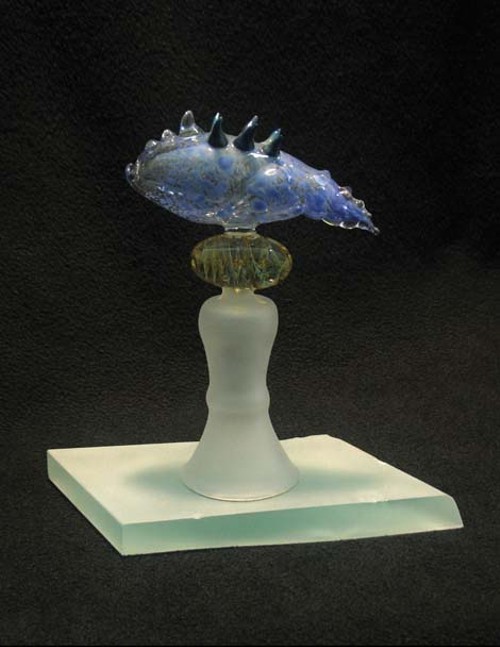Best of 2009 Show
Contemporary Art & Design Gallery shows off some of the year’s finest—and most successful—artistic works.
By Brian Staker @stakerizedIt hasn’t been the best year economically, and that goes double for art—at least as a commodity. There is always the upper tier of the art market that is relatively untouched, but the local art scene tends to be tough even in the best of times. The Best of 2009 Show at Michael Melik’s Contemporary Art & Design Gallery, however, represents not just some of the most significant and memorable work shown locally this year but also some of the most commercially successful artists.
Contemporary Art & Design opened in the Judge Building five years ago, and since 2006, has been sharing a space with the Utah Arts Alliance near 100 S. Main. From the start, Melik—an Azerbaijani immigrant— gathered the work of artists from around the world but primarily Eastern Europe, to show artworks that wouldn’t get exposure here otherwise. The 23 artists in this show demonstrate his confidence in building a roster that is strong and always surprising.
The main featured artist of the show, Karina Kovalenko-Jangulian—originally from Melik’s hometown of Baku—has a moving story as well as striking paintings. Originally a straight landscape painter, since the loss of her son in a car accident, she’s turned to surrealism laced with intense psychological symbolism. “Life Is a Game” depicts wine glasses on a chess board, some broken, and an hourglass in which wine is sifted into sand.
The other two featured artists, Andrew Backus and David Dilworth, bring new work to the space. Backus’ sculptural virtuosity is evidenced in a dizzying array of materials, including ceramic, metal, cast bronze, found wood and bone—the piece “Drifter” is composed of driftwood. Utah State University graduate Dilworth’s cloth triptych, heavily peopled with surreal visages a la Austrian artist Hundertwasser, captures the eye like a trap door into another dimension. Backus and Dilworth are slated as Melik’s first show of 2010.
November’s show featured the drawings of “Daniel” and Tim Wilson’s glass sculptures, with intricate details yet organic shapes like “Cocoon” that resembled the casing of hibernating caterpillar. Sculpture is also represented by Eric Tonks’ metal works and Adrian Prazen from the former Yugoslavia. Terry Willis’ snow-laden landscapes from his October solo show are removed from surrealism, yet the sheen of their surfaces strikes the eye similarly. The paintings on silk by Idaho Falls’ Elise Wilding are another demonstration of art that traveled a relatively short distance geographically yet a longer one aesthetically.
Tim Little’s oversize metal sculptures of animals with a five-figure price tag gave Melik his biggest sale of 2009. Romanian collage artist Matasa uses images from pop art, and Lithuanian Darius Kuzmickas’ pinhole-camera images resemble the breeze-like brushstrokes drawn across the canvas of a pastel painting. Ukrainian Orest Nakonechny only displays one of his talents with his Dali-esque paintings, as he also makes violins, and his gypsy jazz band Rakatanga played the opening on Dec. 4.
The paintings of illustrator Terrell Van Leeuwen—from the June surrealist show with Matasa, Nakonechny and Southern Utah University professor Brian Hoover and several others—almost explode off the canvas. Self-taught painter Grant Fuhst’s Juan Miro-like “Ascension of a Troubadour” is dedicated to the artist’s late brother who was a musician. Steven Teuscher’s mixed media
works garnered some of the most favorable comments during the year, with his watery brushstrokes and hints of figural shapes embedded in the swirl of greenish brown colors seeming to seep out of the surface of the visual plane.
It’s the first time for Melik to show his own paintings, though he has displayed his wood works continuously. His colorful abstract paintings on small wood panels relate to his wood sculptures in their use of the natural knotholes and other shapes in the wood. “It’s a collaboration between myself and nature,” he explains.
Originally, Melik’s exhibits focused on the surrealism that is a strong part of the Eastern European aesthetic, but Melik notes, “I‘ve branched out to landscapes, but to me, these are all contemporary.” It’s more than a business to him—it’s building an aesthetic community. “All these artists have kept me in business, but more importantly, this group is loyal to the gallery, like a family of close friends.”
This ‘family’ has extended from mostly Eastern European artists to simply whatever art strikes Melik as interesting. All styles are represented, from photorealism, expressionism and illustration to glass, wood and metal sculptures.
Traffic to the gallery since the opening has been light, a combination of the slow economy and cold weather, Melik reckons. But his success can be measured in another, perhaps more telling way: “I used to bring new art to Utah, but now new artists are coming to me.”
BEST OF 2009 SHOW
Contemporary Art & Design Gallery
127 S. Main
801-809-6562
Through Jan. 4, 2010
More by Brian Staker
-
Live Music Picks: April 12-18
Judas Priest, The Residents, Clownvis Presley, The Breeders and more.
- Apr 11, 2018
-
Loving the Alienation
Helios Creed and Chrome continue making iconoclastic music for outcasts.
- Mar 28, 2018
-
Live Music Picks: March 22-28
U.S. Girls, Ed Schrader’s Music Beat, Hell’s Belles, Columbia Jones and more.
- Mar 21, 2018
- More »




